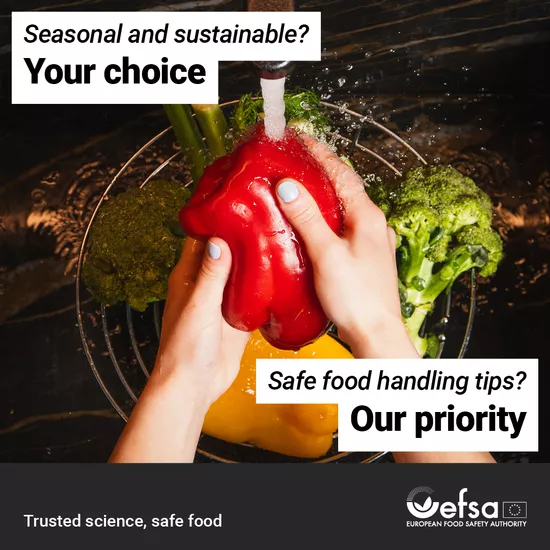Proper food handling
What food hygiene rules should I follow to keep my family safe?
To protect your family from foodborne illnesses, it’s important to follow a few basic food hygiene rules at home.
Unsafe food can contain harmful bacteria, viruses, parasites or chemicals that can cause over 200 different diseases, ranging from diarrhoea to cancers, according to the World Health Organisation (WHO). By following proper food handling techniques, you can significantly reduce the risk of foodborne illness.
There are many practical things we can do at home when it comes to how we store and prepare food. Knowing and following a few basic rules can stop us from getting sick and keep our loved ones safe from foodborne diseases.
Pietro Stella, EFSA veterinary scientist.
Here’s a checklist you can print out and keep in your kitchen:
1. How can I keep food and surfaces clean?
Wash your hands before handling food and during food preparation, and always after using the toilet. Make sure to clean and sanitise all surfaces and utensils used in food preparation. Protect your kitchen and food from pests and animals by maintaining a clean environment.
2. How do I avoid cross-contamination between raw and cooked food?
Separate raw meat, poultry and seafood from other foods. Use different utensils and cutting boards for raw food, and store raw and cooked food separately in the fridge to prevent cross-contamination.
3. How can I ensure my food is cooked thoroughly?
It’s essential to cook meat, poultry, eggs and seafood thoroughly. Use a thermometer to ensure foods like soups and stews reach 70°C, and check that juices from meat are clear, and that the colour of the fish is no longer pink. Reheat food thoroughly to kill any bacteria.
4. How should I store food to keep it safe?
Don’t leave cooked food at room temperature for more than 2 hours. Refrigerate cooked and perishable food promptly (below 5°C) and keep food hot (above 60°C) if serving immediately. Avoid storing food for too long, even in the fridge, as it can affect food safety.
5. How should I defrost food safely?
The safest way to defrost food is in the fridge. Some foods are safe to cook from frozen—always check the packaging for cooking instructions.
6. What water and ingredients should I use for safe food preparation?
Always use clean, safe water for preparing food. Choose fresh, wholesome foods and ensure that any processed foods you use, like milk, are pasteurised for safety. Wash fruits and vegetables thoroughly, especially if eating them raw. Avoid using food past its expiry date.
Handling food safely: essential tips for safe barbecuing
What are the key steps for safe barbecuing?
Barbecuing is a great way to enjoy meals outdoors, but it’s important to follow safety guidelines to prevent foodborne illnesses.
1. How can I keep my hands and surfaces clean while barbecuing?
Wash your hands before handling food and after touching raw meat. Clean all utensils, cutting boards and surfaces thoroughly before and after use.
2. How do I avoid cross-contamination while grilling?
Keep raw meat, seafood and poultry separate from cooked food. Use different plates and utensils for raw and cooked food to prevent cross-contamination. Always clean the grill thoroughly between uses to remove any food particles that could harbour bacteria.
3. How can I ensure food is cooked to the right temperature?
Use a food thermometer to check that your meat reaches the correct internal temperature: check that juices run clear. For fish, check that the meat inside is no longer pink to ensure proper cooking.
4. How can I prevent foodborne illnesses while barbecuing?
Serve food immediately after cooking. If you need to hold cooked food, keep it hot (above 60°C) on the grill. If storing leftovers, refrigerate them promptly, ideally within 2 hours, to prevent bacterial growth.
5. How should I safely defrost food before grilling?
Defrost food in the fridge or microwave—never leave it out on the counter to defrost.
Cooking food to the right temperature is one of the simplest ways to prevent foodborne illness. Using a food thermometer helps ensure that meat and poultry are safe to eat.
Giusi Amore, EFSA veterinary scientist.





































